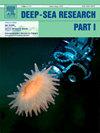Phase transition and gas migration channels evolutions with methane hydrate system in porous media under dynamic leakage conditions
IF 2.1
3区 地球科学
Q2 OCEANOGRAPHY
Deep-Sea Research Part I-Oceanographic Research Papers
Pub Date : 2025-09-01
DOI:10.1016/j.dsr.2025.104579
引用次数: 0
Abstract
Methane, which is widely present in marine sediments, is not only a potential transitional energy source but also plays a critical role in the global carbon cycle. However, in–depth research on the hydrate phase transition and its effects in porous media under dynamic leakage conditions is still lacking. In this study, X-ray computed tomography was employed to capture the real–time three–dimensional structural evolution of hydrate phase transition. The results indicate that hydrate formation expands and stabilizes gas migration channels, increasing their volume to 6.9 times the original, while also enhancing structural complexity and system permeability. During hydrate dissociation, the combined effects of gravity and released gas and water altered the distribution of gas migration channels, reducing both their volume and permeability. On this basis, the ecological and environmental impacts of hydrate phase transition on the deep–sea methane seepage areas under dynamic seepage conditions were analyzed. Hydrate phase transition playing a crucial role in the biogeochemical processes and the evolution of benthic ecological communities in methane seepage areas. This study demonstrates the role of hydrate phase transitions in reshaping gas migration channels under dynamic leakage, with implications for ecological processes and hydrate resource development in marine sediments.
动态泄漏条件下多孔介质中甲烷水合物体系相变及运移通道演化
甲烷广泛存在于海洋沉积物中,不仅是一种潜在的过渡性能源,而且在全球碳循环中起着至关重要的作用。然而,对于动态泄漏条件下多孔介质中水合物相变及其影响的深入研究仍然缺乏。本研究采用x射线计算机断层扫描技术实时捕捉水合物相变的三维结构演化过程。结果表明,水合物的形成扩大和稳定了天然气运移通道,使其体积增加到原来的6.9倍,同时也提高了结构复杂性和系统渗透率。在水合物解离过程中,重力和释放的气、水的共同作用改变了气体运移通道的分布,使其体积和渗透率降低。在此基础上,分析了动态渗流条件下深海甲烷渗流区水合物相变对生态环境的影响。水合物相变在甲烷渗漏区生物地球化学过程和底栖生物群落演化中起着至关重要的作用。该研究揭示了动态泄漏条件下水合物相变在重塑天然气运移通道中的作用,对海洋沉积物的生态过程和水合物资源开发具有指导意义。
本文章由计算机程序翻译,如有差异,请以英文原文为准。
求助全文
约1分钟内获得全文
求助全文
来源期刊
CiteScore
4.60
自引率
4.20%
发文量
144
审稿时长
18.3 weeks
期刊介绍:
Deep-Sea Research Part I: Oceanographic Research Papers is devoted to the publication of the results of original scientific research, including theoretical work of evident oceanographic applicability; and the solution of instrumental or methodological problems with evidence of successful use. The journal is distinguished by its interdisciplinary nature and its breadth, covering the geological, physical, chemical and biological aspects of the ocean and its boundaries with the sea floor and the atmosphere. In addition to regular "Research Papers" and "Instruments and Methods" papers, briefer communications may be published as "Notes". Supplemental matter, such as extensive data tables or graphs and multimedia content, may be published as electronic appendices.

 求助内容:
求助内容: 应助结果提醒方式:
应助结果提醒方式:


